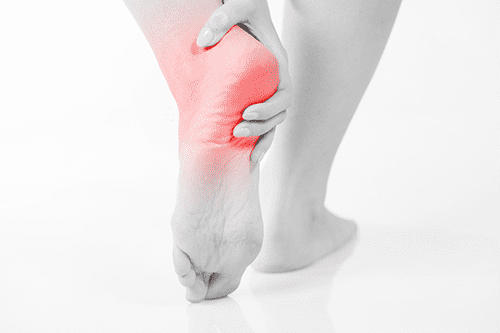Heel Pain

Heel pain most commonly affects the underside or back of your heel. Although this type of pain in the foot is rarely a symptom of a serious condition, it can interfere with your normal activities, particularly exercise. A sore heel will usually improve with time, rest and the right treatment. Unfortunately, many people ignore the early signs of heel pain and keep on doing the activities that caused it. This can make the problem worse and potentially lead to chronic heel pain.
Heel Pain Causes
The most common causes of heel pain are:
- Plantar fasciitis (bottom of the heel)
- Achilles tendinitis (back of the heel).
Other causes of heel pain can include:
- Achilles tendon rupture
- Bone tumor
- Bursitis (joint inflammation)
- Haglund's deformity
- Heel spur
- Osteomyelitis (a bone infection)
- Paget's disease of bone
- Peripheral neuropathy
- Reactive arthritis
- Retrocalcaneal bursitis
- Rheumatoid arthritis (inflammatory joint disease)
- Sarcoidosis (collections of inflammatory cells in the body)
- Foot or ankle stress fractures
- Tarsal tunnel syndrome
When to Seek Treatment for Heel Pain
If you have any of the following symptoms related to heel pain, it’s a good idea to be evaluated by a doctor who specializes in foot and ankle conditions immediately:
- Severe heel pain immediately after an injury
- Severe pain and swelling near your heel
- Inability to rise on your toes, walk normally or bend your foot downward
- Heel pain with fever
- Tingling or numbness in the heel
Additionally, if you have heel pain that lasts for more than a few weeks – even after home treatments like rest and icing – it’s a good idea to seek treatment. Additionally, heel pain that continues when you’re not putting pressure on the foot (walking or standing) could indicate a problem that requires medical care.
Medical Treatment for Heel Pain
Treatment will depend on the underlying reason for the heel pain. You may need to do special exercises, wear a heel pad or insert or take steps to reduce inflammation. If your doctor suspects a bone spur may be causing the pain, you will need an X-ray to see if a bone spur is present.
Heel Pain Self-Care
Heel pain may resolve with simple home care. Here are some things to try:
- Rest: Avoid activities that put stress on your heels, such as running, standing for long periods or walking on hard surfaces.
- Ice: Ice your heel for 15 to 20 minutes three times a day.
- Over-the-counter pain medications: Aspirin or ibuprofen (Advil, Motrin IB, others) can reduce inflammation and pain
- Good shoes: Be sure your shoes fit properly and provide good support. If you're an athlete, choose shoes appropriate for your sport and replace them often.
- Foot supports: Heel cups or wedges that you buy in the drugstore often provide relief.
Please remember that if heel pain does not go away after taking self-care measures, it’s a good idea to be evaluated by a doctor who specializes in foot and ankle conditions such as Dr. Flynn.
Podiatric
Speciality Areas
Achilles Tendonitis
When Achilles tendinitis strikes, it can seem like it will never end and your life can be limited in significant ways.
Heel Pain
Heel pain interfere with your normal activities, particularly exercise. Reach out to us if you’re experiencing unresolved heel pain.
Ankle Fracture
It can be hard to distinguish if the ankle is broken or sprained, as symptoms can be similar. Reach out for support.
Hammer Toe
A hammertoe is a result of an imbalance in the soft tissue surrounding your toe, including your tendons, ligaments, and muscles.
Ankle Replacement
Patients who chose ankle replacement surgery usually have advanced arthritis that severely limits their daily activity. Learn more.
Orthotics
When structural irregularities are the culprit, orthotics can help restore balance to your feet.
Bunion & Bunion Surgery
The Bunionplasty® 360 Bunion Repair™ procedure is changing the game when it comes to eliminating bunions with faster recovery. You can even walk the day of surgery.
Plantar Fasciitis
This band of tissue, which runs from the base of your toes to your heel, can cause a lot of pain.
Charcot Foot
Charcot of the foot and ankle is a very serious condition as it may lead to severe deformity, disability, or even worse, amputation.
Sprained Ankle
A sprained ankle will come with pain, swelling and tenderness. If pain has been ongoing, it may be time for help.
Flat Foot Reconstruction
People who have flat feet have little or no arch. In serious cases, flat foot reconstruction may be needed.
Ingrown Toenail
An ingrown toenail may seem small but can cause inflammation and tenderness. We can help alleviate your pain.











